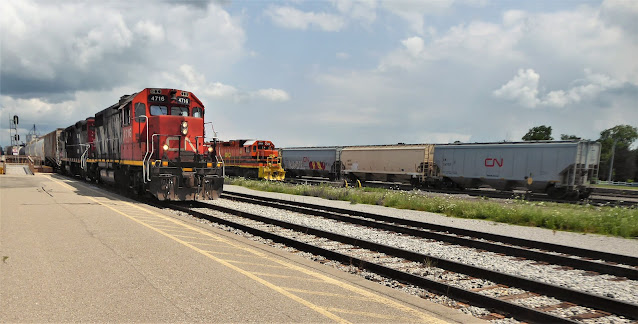Today seems like the typical October day we are all accustomed to here in Ottawa. It's cold, rainy and the leaves are falling from the trees like the rain. We're finally seeing some colour in the leaves, thanks to the overly warm late summer weather vacating the region.
I haven't done a great deal of railfanning lately, some of which is due to a stressful situation that has been ongoing since early September. This has taken its toll on my mental health. I don't usually share things like this on here, but this is the reason my posts have not been punctual and I really don't know what hiding the reasons does for me. As a mental health public speaker, I am reminding myself to just own it. So, that is my explanation.
I did get trackside earlier this week and noticed that the Siemens work crews were busy dismantling an old industrial spur near Hunt Club Road, on the Smiths Falls Subdivision. This image below, taken from the Hunt Club overpass, shows some of the results of the work on the mainline.
Siemens is the successor to RailTerm, which was the company that maintained much of Via's network of tracks in this city. The old spur, which once connected a few businesses on Bentley Avenue to the mainline, still runs behind a few light industrial operations. This image below shows the spur's connection to the mainline now completely dismantled.
The trackage behind the fence doesn't look like it's been used in a number of years, as much of the trackage is completely surrounded by brush and weeds. I can't even begin to guess when there was last rail service to this spur. It seems like 10 years at the very least.
This shot below shows the old switch stand, ready to be hauled away.
While I was up on the overpass, I waited for westbound Via Train 59, which passes by this area every evening around 6 p.m., which works for me as I am in the area waiting for my daughter's dance class to finish.
I've been setting up here for a few weeks, while I still have some evening light, but I'm thinking that the gathering darkness at this hour will shut down my weekly shots of this train for a while. To be honest, I've run out of ideas for new ways to shoot this train. I've been trying to get a fall shot with lots of colours in the trackside trees, but the unusually warm weather has kept much of the foliage from turning colour. You can see hints of colour in this shot, but it's not what I wanted.
I'm hoping that, possibly, things will get a bit more interesting soon, as Via Rail has expanded the usage of its new Siemens train sets to include a number of Ottawa-Toronto trains. It'll be nice to get some shots of the new equipment, while there's still a novelty to it. I'm sure we'll grow a bit tired of it soon enough.
Also, OC Transpo is testing its new diesel light rail trains on the expanded Trillium Line, which will now connect from its former southern terminus at Greenboro to Riverside South, with a branch to the Ottawa International Airport. This is likely cold comfort to people who rely on this service, as it was slated to be operational by the end of the year, but is now scheduled to begin next year. The delay is disappointing, but given the complexities of the pandemic and severed supply lines, it's not a big surprise that these delays pushed back the start date.
Hat tip the Bytown Railway Society for completing its long renovation of CN passenger coach 4977. The BRS showed off the newly refurbished car on its Facebook page recently and it looks great in its olive green livery. Given the limitations of what the society can do on its trackage at the Canada Museum of Science and Technology, it seems like the society is going to try and find a home for the car where can it can actually be put to use. It's a shame the BRS no longer has access to active rails.
Another tip of the hat to the BRS for successfully completing the new home for its 4-8-4 steam locomotive 6200 on the lawn in front of the museum. The move to a new spot necessitated the laying of temporary track and a move of the old hulk for the first time in many years. The old brute looks great, as the BRS made a few cosmetic upgrades to give the engine a nice shine that befits its status as an Ottawa icon.
Here's a shot of the engine from 10 years ago, without its number plates or brass bell. Its looks evene better now.
I'm hoping to have a little more to share in the coming weeks, as my family will be travelling and I will have the chance to get to other parts of the city, due to a number of appointments outside my west-end neighbourhood. Sometimes, I need the necessity of appointments and business to get out there and explore a bit soemtimes. Whatever it takes.













.png)